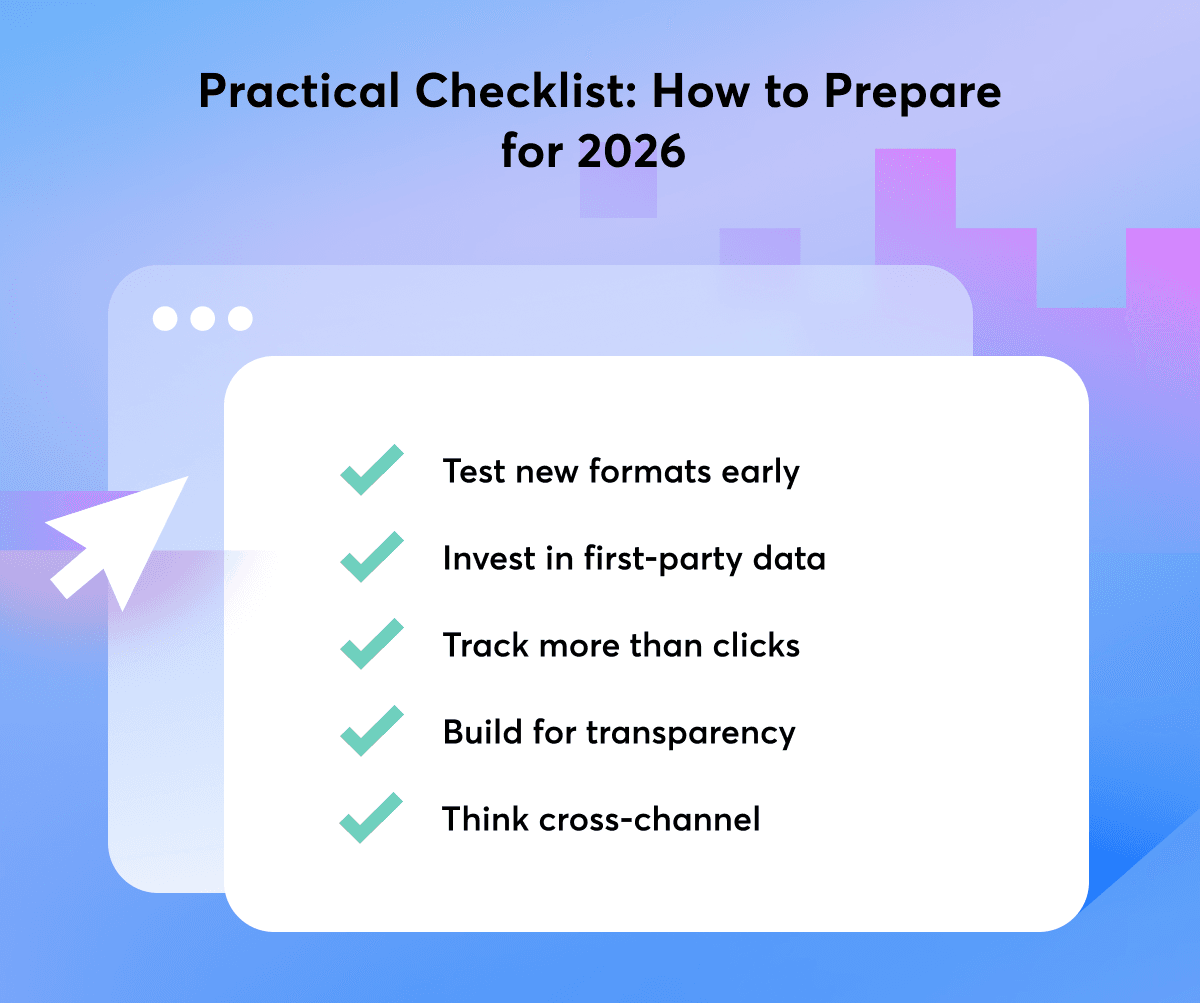Affiliate marketing is getting a much-needed refresh. People have learned to tune out banners and pop-ups that follow them around the web. Native ads are finding their second wind — not by shouting louder, but by blending in where attention already lives. For affiliates, this approach feels more authentic and keeps audiences engaged longer.
Looking ahead to 2026, the role of native ads is set to expand even further. Instead of just blending into articles or feeds, they’re moving toward shaping the entire customer journey — from the first spark of interest to the final conversion. The spotlight is shifting from raw impressions to real attention, from cookie-driven targeting to experiences built on context and first-party data.
The bigger question for the next year isn’t whether native ads will matter in affiliate marketing — they already do. It’s about how they’ll evolve in line with the advertising trends now defining the industry, and what that means for affiliates trying to stay ahead of the curve.
Why Native Advertising Is Becoming Core to Affiliate Marketing
Affiliate marketing has always been about staying quick on its feet. The old tricks — banner overload, pop-ups on every page, recycled creatives — just don’t cut it anymore. People scroll past without noticing, and platforms now expect higher-quality engagement. That shift has moved native advertising from the sidelines to the center of performance strategy.
The strength of native is the way it blends with content. Instead of breaking a session, it extends it. For affiliates, that means the ad often gets read as part of the story. When it’s relevant and well-placed, trust goes up, clicks mean more, and ROI follows. By 2026, that’s not a niche move — it’s the standard.
Native also travels the whole journey. It plants the first idea with an on-page headline, deepens interest with short video, polls, or quick explainers, and lands the sale with a context-aware offer. That continuity is exactly what brands need as privacy rules tighten and third-party signals fade — the message carries the work, not the tracker.
In short, native has gone from supporting roles to lead in affiliate marketing. And heading into 2026, the top performers will treat it not as a format, but as the framework for growth.
Key Advertising Trends Shaping 2026
Affiliate marketing doesn’t stand still. By 2026, the key advertising trends show a market that’s faster, more visual, and far less forgiving of copy-paste creative.
One clear trend in advertising is short-form video. Vertical clips under 30 seconds have become the language of the scroll. Affiliates still leaning on static banners are already losing ground.
Artificial Intelligence is also part of the picture. The IAB report projects that by 2026, around 40% of video ads will be created or enhanced using AI. MGID is already ahead of this trend — our CTR Guard tool applies AI to refresh fatigued creatives automatically, extending their lifecycle and helping campaigns sustain high performance.
Soon, MGID will also introduce AI-powered video generation from static creatives and campaign statistics, taking optimization to the next level. By detecting when engagement starts to drop and generating optimized variations, CTR Guard ensures that affiliates don’t just keep up with changing user behavior, but turn it into a growth advantage.
Privacy rules are forcing another shift. With cookies gone, first-party data and contextual targeting are now the basics. For affiliates, that means sharper audience splits and messaging that feels human, not automated.
All of this adds up to the look of trending ads in 2026: fast to catch attention, easy to watch, and built around context. They don’t fade into the background — they stand out and drive results.
New Trends in Native Advertising for Affiliates
Some of the most interesting shifts are happening inside native itself. The recent trends in advertising show that native is moving away from clickbait banners with flashy images and “buy now” offers, evolving toward more authentic and value-driven content. It’s now built to move people all the way from discovery to conversion.
One of the new trends in advertising is the rise of interactive formats. Quizzes, polls, and mini-games are being used to qualify traffic and keep audiences engaged for longer. For affiliates, that means higher-quality leads and better data for retargeting.
Video is another big driver. As feeds become video-first, native placements are evolving into sponsored clips, creator integrations, and vertical stories. This is the future of native advertising: ads that don’t just sit next to content but blend with it in form and flow.
We’re also seeing a shift toward omnichannel paths. A native ad on a news site can now connect directly with a shopping cart, a social story, or a streaming platform. That seamless handoff is what affiliates need to keep users moving from curiosity to purchase without friction.
The Future of Affiliate Marketing 2026 — Through the Lens of Native Ads
Measuring Beyond the Click
In 2026, affiliates won’t be judged just by conversions. Metrics like retention, lifetime value (LTV), and engagement beyond the first click will matter more. Native ads let you shape that experience — not just trigger a jump to an offer, but lay the groundwork for longer-term relationships.
Fraud, Trust & Growing Scrutiny
As affiliate budgets grow, so does adversary pressure. Fraud in affiliate channels is already a serious menace. In 2025, the industry faces losses in the order of $84 billion due to ad fraud tactics such as hijacking, cloaking, and fake coupons.
Marketers should focus on choosing reliable platforms that ensure transparent traffic quality and verified results. MGID, for instance, combines its proprietary TAG-certified anti-fraud solution with third-party verification tools like IAS, Anura, and Impact.com, maintaining brand safety and filtering out invalid traffic at every stage of the funnel.
Native as a Framework, Not Just an Option
By 2026, native ads won’t be just one format among many — they’ll be the operating system for affiliate strategies. They’ll connect awareness to intent, apply context to creative, and serve as the glue between publishers, networks, and performance goals.
The affiliates who embrace that shift — building for trust, measurement, and resilience — are the ones who will define the next wave of growth.
What This Means for Advertisers and Publishers
For advertisers
If you’re running campaigns, think of native ads as part of the content, not as another banner squeezed onto the page. A short headline, a clear benefit, and one proof point will work better than trying to say everything at once.
Make your creative set flexible: prepare a mix of short and long versions (6, 15, and 30 seconds), adapt them to square and vertical formats, and don’t forget a few strong static images. Updating them weekly helps avoid ad fatigue.
Target smarter. Instead of spraying ads everywhere, pair your first-party data with contextual signals that match user intent.
Measure what happens beyond the click. Track how far people scroll, how long they stay on site, whether they add items to cart, and even the long-term value of affiliate traffic.
And always keep safeguards in place: pre-bid brand safety checks, post-click quality reviews, and clear disclosure in plain language.
For publishers
For publishers, less is often more. A few well-placed widgets that load fast and fit the site’s typography will outperform clutter.
Place units where user intent is strongest — just below the first screen, midway through an article, or at the end of a video.
Respect your readers by limiting how many times they see the same ad in one session, and rotate categories to keep the feed feeling fresh.
Editorial tags can do a lot of heavy lifting: send finance offers to finance pages, health offers to health sections. It raises relevance without relying on invasive tracking.
And above all, protect trust. Use clear “sponsored” labels, keep the tone consistent, and make sure the transition to the advertiser feels seamless.
Why it matters for 2026
The advertising trends shaping the year reward relevance and page experience. Formats that read like the feed — the true trending ads — earn attention without burning the audience. Do that, and both sides win: advertisers see performance, publishers keep loyalty.
Practical Checklist: How to Prepare for the Future Now
The advertising trends shaping 2026 aren’t abstract forecasts — they’re road signs. Affiliates, advertisers, and publishers can act on them today. Here’s what should be on the checklist:

- Test new formats early. Don’t wait until your competitors are already running polls, shoppable video, or AR try-ons. Try them, measure, and refine.
- Invest in first-party data. With cookies gone, your own audience insights are your biggest asset. Collect them responsibly and use them to fuel smarter campaigns.
- Track more than clicks. Engagement time, scroll depth, or repeat visits are stronger signals of quality than CTR alone. The new trends in advertising reward long-term attention.
- Build for transparency. Disclosures, clean landing pages, and fraud checks aren’t optional. They’re part of building trust.
- Think cross-channel. The future of native advertising is not limited to news sites. It flows across feeds, video platforms, and retail media. Plan creative that adapts to each step of the journey.
Affiliates who put these basics in place now won’t just keep pace — they’ll be in position to lead when 2026 arrives.
Conclusion
Native ads have moved from the margins to the center of affiliate marketing. The trends in advertising shaping 2026 show a clear direction: trust, context, and attention now matter more than raw reach.
Looking ahead, the future of native advertising isn’t about another format in the mix — it’s about how affiliates, advertisers, and publishers build their entire strategy. Those who test fast, work with first-party data, and keep user trust front and center will set the pace.
The future of affiliate marketing 2026 won’t reward the loudest voices, but the ones that feel the most relevant.





